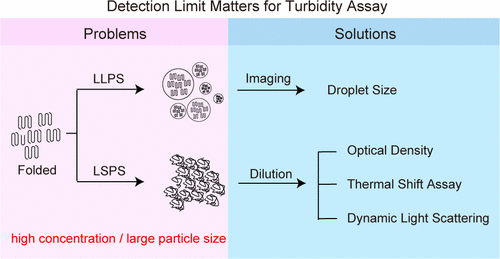当前位置:
X-MOL 学术
›
Biochemistry
›
论文详情
Our official English website, www.x-mol.net, welcomes your
feedback! (Note: you will need to create a separate account there.)
Common Pitfalls and Recommendations for Using a Turbidity Assay to Study Protein Phase Separation
Biochemistry ( IF 2.9 ) Pub Date : 2021-08-09 , DOI: 10.1021/acs.biochem.1c00386 Yanan Huang 1 , Yulong Bai 1, 2 , Wenhan Jin 1 , Di Shen 1 , Haochen Lyu 1 , Lianggang Zeng 1 , Mengdie Wang 1, 2 , Yu Liu 1
Biochemistry ( IF 2.9 ) Pub Date : 2021-08-09 , DOI: 10.1021/acs.biochem.1c00386 Yanan Huang 1 , Yulong Bai 1, 2 , Wenhan Jin 1 , Di Shen 1 , Haochen Lyu 1 , Lianggang Zeng 1 , Mengdie Wang 1, 2 , Yu Liu 1
Affiliation

|
The turbidity assay is commonly exploited to study protein liquid-to-liquid phase separation (LLPS) or liquid-to-solid phase separation (LSPS) processes in biochemical analyses. Herein, we present common pitfalls of this assay caused by exceeding the detection linear range. We showed that aggregated proteins of high concentration and large particle size can lead to inaccurate quantification in multiple applications, including the optical density measurement, the thermal shift assay, and the dynamic light scattering experiment. Finally, we demonstrated that a simple sample dilution of insoluble aggregated protein (LSPS) samples or direct imaging of liquid droplets (LLPS) can address these issues and improve the accuracy of the turbidity assay.
中文翻译:

使用浊度测定研究蛋白质相分离的常见缺陷和建议
浊度测定通常用于研究生化分析中的蛋白质液-液相分离 (LLPS) 或液-固相分离 (LSPS) 过程。在此,我们介绍了由于超出检测线性范围而导致的该检测的常见缺陷。我们发现高浓度和大粒径的聚集蛋白会导致多种应用中的定量不准确,包括光密度测量、热位移测定和动态光散射实验。最后,我们证明了不溶性聚集蛋白 (LSPS) 样品的简单样品稀释或液滴 (LLPS) 的直接成像可以解决这些问题并提高浊度测定的准确性。
更新日期:2021-08-17
中文翻译:

使用浊度测定研究蛋白质相分离的常见缺陷和建议
浊度测定通常用于研究生化分析中的蛋白质液-液相分离 (LLPS) 或液-固相分离 (LSPS) 过程。在此,我们介绍了由于超出检测线性范围而导致的该检测的常见缺陷。我们发现高浓度和大粒径的聚集蛋白会导致多种应用中的定量不准确,包括光密度测量、热位移测定和动态光散射实验。最后,我们证明了不溶性聚集蛋白 (LSPS) 样品的简单样品稀释或液滴 (LLPS) 的直接成像可以解决这些问题并提高浊度测定的准确性。











































 京公网安备 11010802027423号
京公网安备 11010802027423号